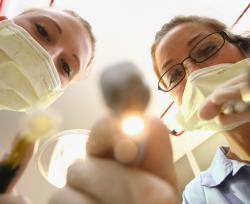Watching tonight’s Frontline documentary made me grateful for web journalism and its infinite elasticity. “Dollars and Dentists”—about the extreme difficulties millions of Americans, including children with government-provided insurance, experience getting dental treatment—tells an important story about a key part of the U.S. health care system that is usually ignored. But squeezing a complicated story into a 50-minute film leads to scapegoating and avoids the most fundamental questions about dentistry: Why does dental treatment cost so much, and why do we treat health problems of the mouth so differently from medical issues that afflict the rest of the body?
The film—which should be watched by everyone except those who are convinced they will never have a problem paying for their family’s dental care—makes the usual visit to a giant parking lot full of desperate people seeking free treatment. It devotes a segment to the kinds of for-profit children’s dental clinics that often appear in local TV news exposés during sweeps month, and another to the less frequently covered problems of adults who can’t afford (or don’t think they can afford, or who are simply too scared) to visit a private dentist for relief of pain and who end up in clinics that may pressure them to have teeth extracted and dentures fitted.
These problems are familiar to me, but people who have always had dental insurance and have never needed procedures that require them to shell out significant co-pays will probably be surprised. They’ll no doubt be shocked to hear from the grandmother who called 10 dental offices but couldn’t get an appointment for her 5-year-old granddaughter who has Medicaid insurance. (State reimbursements don’t cover dentist’s costs, so in states like Florida, only 10 percent of private dentists—and more than 90 percent of U.S. dentists are in private practice—see Medicaid patients.) They’ll be surprised that adults who head to hospital emergency rooms for relief of dental pain end up with bills for thousands of dollars even though ERs can’t begin to address the fundamental problems that cause the pain in the first place. They may even be shocked that “traditional dentists” have tried to shut down nonprofit clinics like Alabama’s Sarell Dental Center, which provide much-needed treatment.
There are fundamental challenges to covering dentistry that are difficult to avoid. When moms complain that their kids were screaming in the dental chair, or that it seemed to them that some of the procedures the dentist undertook might not have been necessary, it’s tough to admit that those parents might not be experts in the field. (Which doesn’t mean that every procedure was necessary—just that a mother’s unease isn’t dispositive.) When documentaries repeatedly use phrases like “corporate dental chains” “backed by private equity firms,” you might forget that private dentists also run for-profit businesses. (And, of course, those chains might indeed be pressuring the dentists they employ to meet billing targets; though, again, let’s not forget that private dentists also have profit targets. We just have more reason to trust them.) When for-profit clinics encourage people to sign up for special credit cards and give 87-year-old women treatment plans for procedures that will cost nearly $8,000, it’s worth asking how much a private-practice dentist would have charged—if she could’ve gotten an appointment. (Medicare doesn’t include dental coverage.)
If the Frontline documentary is a little sensationalistic, it’s probably because the problem is so enormous and so underappreciated. “Dollars and Dentists” is a flawed show, but an essential first step to public awareness.
